Friends, hi! It’s Progressive Eats day, and this month, Jane from The Heritage Cook is hosting! Come see what we have going on for a New Year’s Eve Blowout Celebration! (Spoiler Alert: I made champagne yeast brioche bread.)
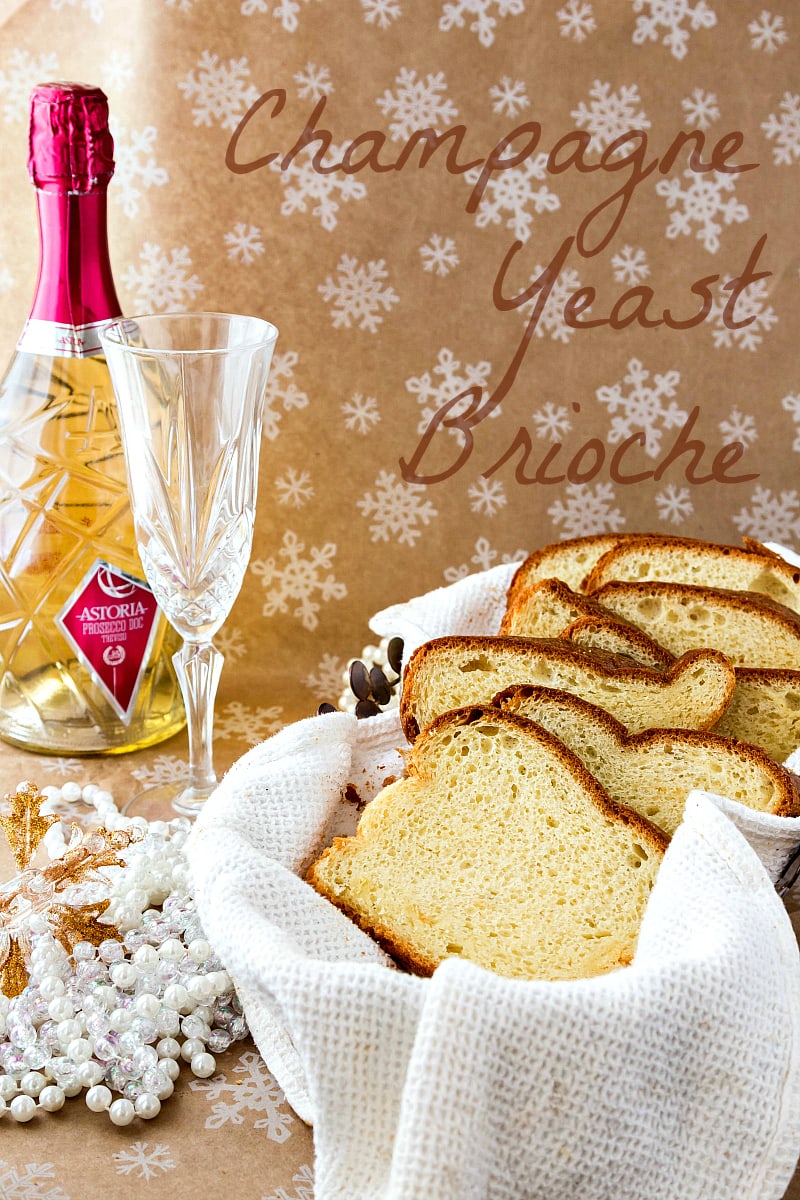
A New Year’s Eve Extravaganza
Welcome to another edition of Progressive Eats, our virtual version of a progressive dinner party where each course is held at a different home. With Progressive Eats, a theme is chosen each month, members share recipes suitable for a delicious meal or party, and you can hop from blog to blog to check them out.
Pastry Chef Online Participates in Affiliate Programs. If you make a purchase through one of my links, I may earn a small commission. For more information click to read my disclosure policy
This month’s theme is a New Year’s Eve Extravaganza hosted by Jane of The Heritage Cook. Enjoy these jaw-dropping recipes, complete with my recipe for champagne yeast brioche, ideal for any special occasion and the perfect way to ring in the New Year!
Let’s check out the menu, shall we? Then I’ll tell you all about how I made my champagne yeast brioche bread. Yay!

New Year’s Eve Extravaganza!
Cocktails
- Pomegranate Champagne Cocktail from That Skinny Chick Can Bake
- Fancy Free Cocktail from The Food Hunter’s Guide
Appetizers
- Baked Brie with Cabernet Cranberry Cherry Sauce from The Redhead Baker
Bread
- Champagne Yeast Brioche from Pastry Chef Online (you’re here!)
First Course
- Lobster and Crab Chowder from The Wimpy Vegetarian
Main Course
- Beef Filet Steaks with Homemade Bearnaise Sauce from The Heritage Cook
Side Dishes
- Puff Pastry Potato Roses from Mother Would Know
Desserts
- Yuzu Cheesecake from Spice Roots
- Chocolate Orange Stout Cake with Orange Frosting from Creative Culinary
Champagne Yeast Brioche Bread
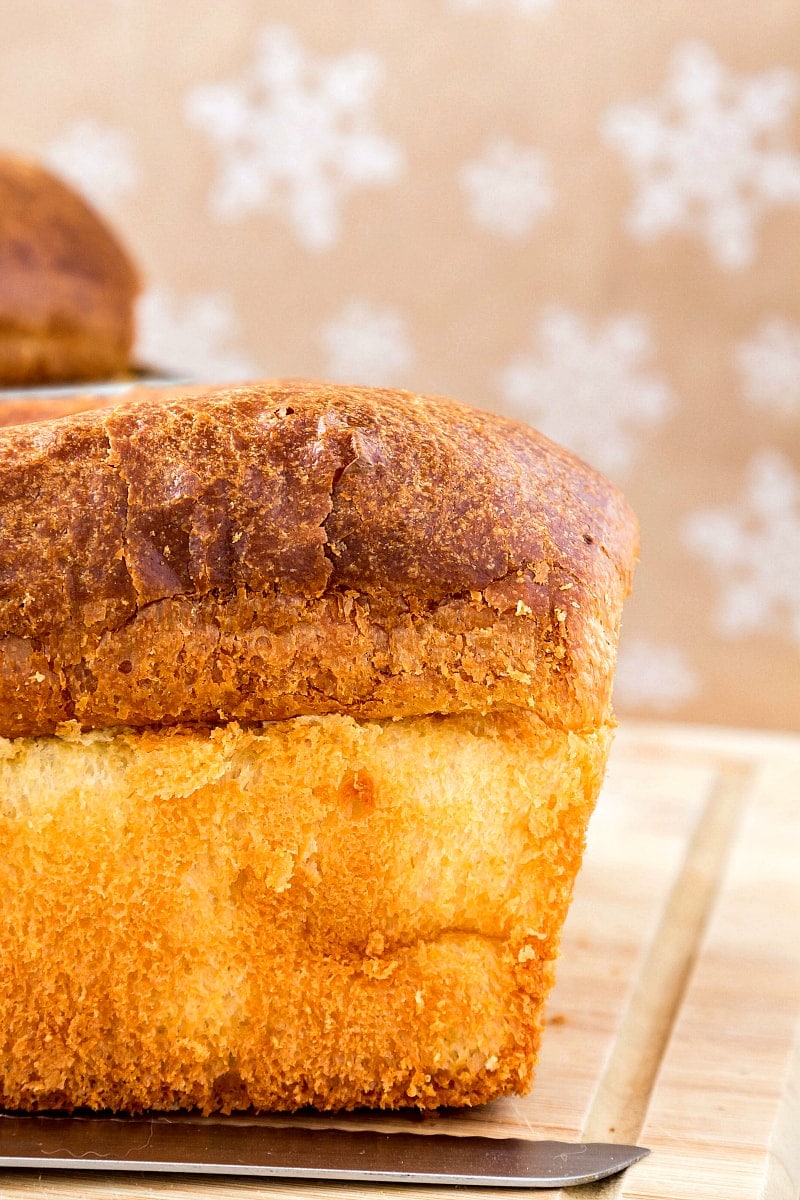
Champagne Yeast Brioche Bread
Brioche is sort of an impossible dough. A mere .15 oz of yeast is commanded to raise not only just over a pound of flour, but 17 oz of butter along with 12 oz of eggs. Craziness!
But, given enough time, the magic happens. Finished brioche dough is so soft and shiny, it almost behaves like pate a choux. Impossible to shape by hand.
A good overnight chill firms up the butter allowing some fast shaping, and then a long, slow rise allows the yeast to do their thing at their leisure.
The resulting loaf is light yet rich–a bit of a contradiction. Once you have your brioche, you can use it for sweet or savory applications.
Here are some Serving Suggestiong:
- Slather it with butter and honey or jam
- Spread on some rustic pate would be just as at home.
- Use balls of dough dipped in cinnamon and sugar to make a super fancy monkey bread
- Turn your dough into rich, round sandwich buns perfect for sopping up the juices from a perfectly cooked burger
If making burger buns, scale them at 4 ounces each.
The brioche I made for you today is the same formula I used to use for brioche at the restaurants I worked in. The only difference I’ve made is to use champagne yeast rather than regular baker’s yeast.
Baking with Brewer’s Yeast
Baking with brewer’s yeast is no different than baking with your tried and true regular yeast. And while you might not be able to tell the difference between a loaf baked with one type of yeast one day and a bread baked with another type of yeast on a different day, when you bake with different strains of yeast head to head, the differences become apparent.
If you’d like to read about my experiments baking the same loaf of bread with four different strains of yeast, you can read my post The Four Loaves of the Apocalypse, or Baking with Brewer’s Yeast.
The main difference I could discern between this champagne yeast brioche bread and the ones I used to make is the smell of alcohol while the bread is still warm.
There’s a bit of brut funk that I’m sure is one of the characteristics of using champagne yeast. As the bread cooled, the smell dissipated, and once at room temperature, the champagne yeast brioche bread was a lovely example of a tight-crumbed, rich, tender, cake-like brioche.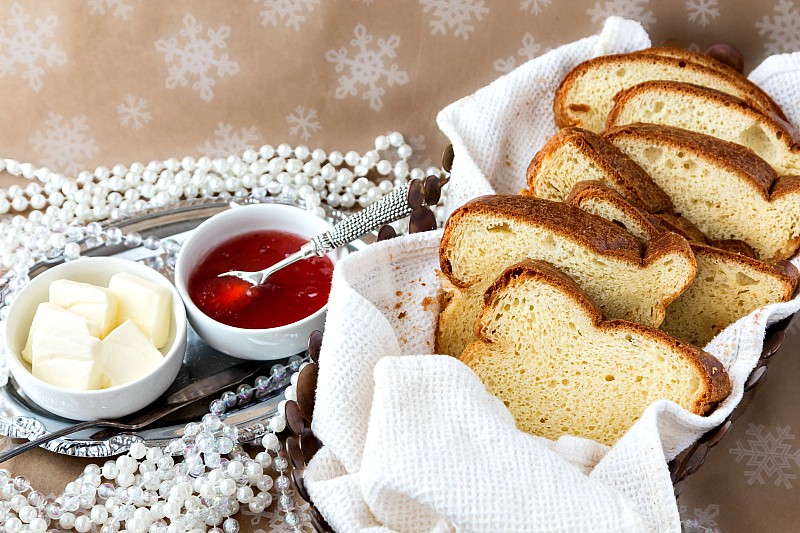
The Mixing and Baking Schedule
You’ll want to know how to schedule your time:
- I made the sponge in the morning and let it rest until bubbly. This took about 3 hours, even in a cozy environment. I think this is probably because the yeast are used to working with more sugar–hello, grape juice–than what was present in my sponge, so it took it awhile to get going. Once it got going, though, the sponge bubbled like a champ and the bread rose beautifully in the pans.
- After making the sponge, I added all the rest of the ingredients and mixed them, kneading for roughly ten minutes before adding the butter very slowly–over about 15 or 20 minutes or so.
- Once the dough was ready, I refrigerated it for 8 hours.
- Remove from the fridge and allow to rise on the counter until the dough peeks over the sides of the pan, about 6 hours or so.
This schedule saw me shaping and panning the cold dough at 10 pm and allowing it to rise overnight in the cool kitchen. I baked at 8 am.
That was too much for the second proof, so stick with about 6 hours.
As you can see from some larger air pockets in the finished bread and the rather dented top of my loaves, my bread was somewhat overproofed.
While perhaps not the most aesthetically pleasing loaves, their flavor didn’t suffer and I took great joy in plowing through a couple of slices with butter, jam, and honey.
I know there are a lot of steps and a ton of waiting around time, but you will be rewarded with 2 champagne yeast brioche loaves you will be proud to serve. Or eat alone without sharing.
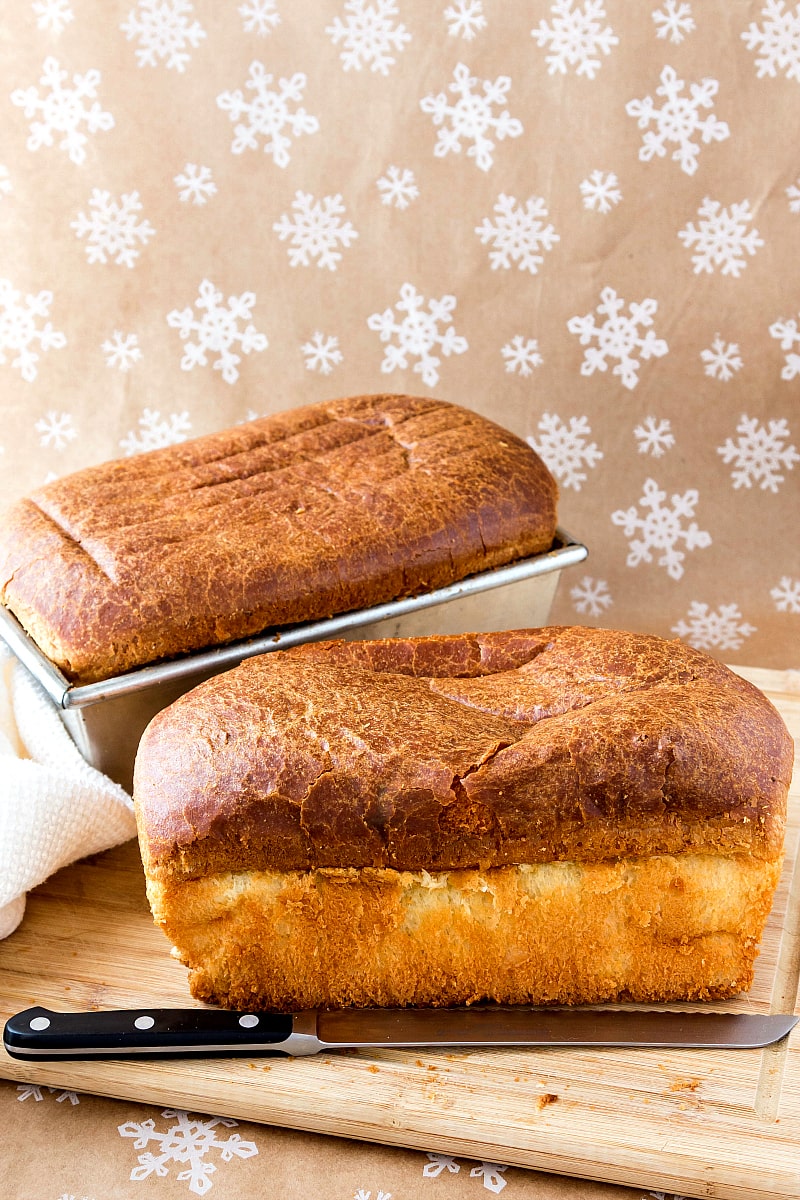
Since my guys were over-proofed, I would suggest making the dough in the evening before a day you can hang out at home. Then, you can refrigerate the dough overnight and shape and let proof in the morning. Even in the hot restaurant kitchen, the dough seemed to take forever to rise, so I would count on a good 5-7 hours in a home kitchen. Then, it’s all over but the baking, and that only takes about 30 minutes.
Be Mindful of the Butter
The last thing you want to do to the gorgeous champagne yeast brioche dough you worked so hard to make is to allow the butter to leak out during proofing.
And this means you have to resist the urge to try to speed things along by letting the dough rise in a cozy place.
Cozy equals melted butter, and we want it to stay in the bread and not soak back in after baking. So, a longer, cooler rise is preferable to a shorter, warmer rise.
Enough talk.
>Let’s make champagne yeast brioche bread.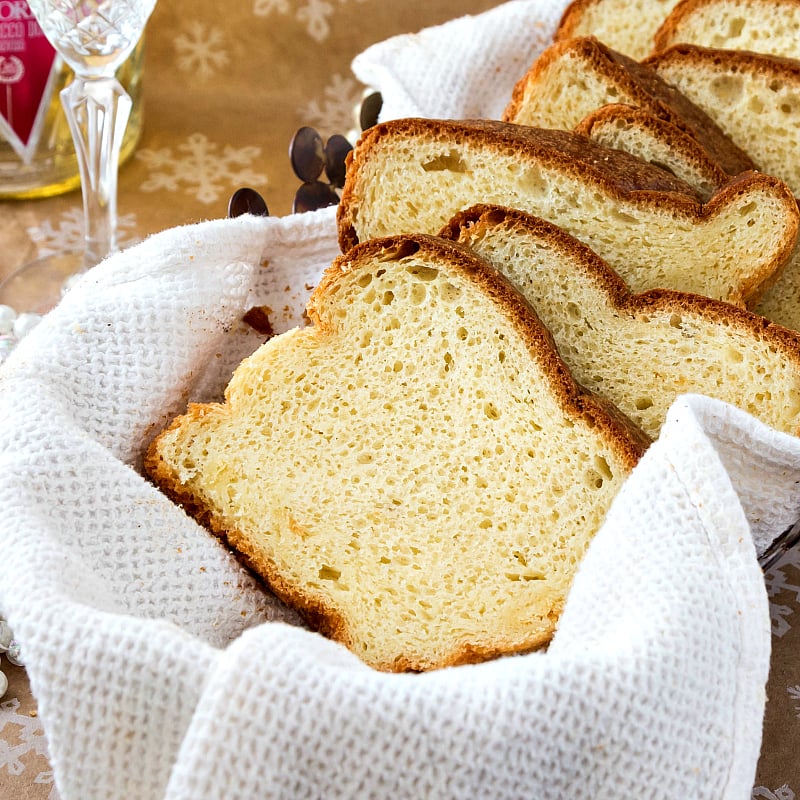
What Does This Brioche Taste Like?
Brioche was most likely the cake to which Marie Antoinette was referring when she said, “Let them eat cake.”
Brioche is a bit of a hybrid: yeast raised like a bread and rich with eggs and butter like cake.
The loaf by itself is not overly sweet, but it lends itself well to both sweet or savory pairings.
Using champagne yeast to make the dough ups the celebratory factor and makes this champagne yeast brioche perfect for your New Year’s Eve Extravaganza!
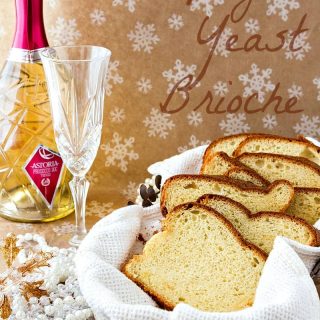
Champagne Yeast Brioche Bread | Progressive Eats
Would you like to save this post?
Ingredients
For the Sponge
- 3 oz water
- 2 oz whole mik
- .15 oz dry champagne yeast (available online or from your local home brew store)
- .15 oz sugar
- 4 oz bread flour
For the Dough
- All the sponge
- 12 oz whole eggs (6 or 7--weigh them out of the shell)
- 1.75 oz sugar
- .33 oz kosher salt
- 11 oz bread flour
- 3.75 oz all purpose flour
- 17 oz butter softened and beaten with the paddle attachment or with a hand mixer until smooth
Instructions
For the Sponge
- Combine all ingredients in the bowl of your stand mixer and stir well to combine.
- Cover and let rise in a warm, cozy place until the sponge is very bubbly. This could take 2-3 hours.
For the Dough
- Add all the dough ingredients except the butter to the sponge.
- Place the bowl on your mixer and fit it with the dough hook.
- Mix on low speed for about 3 minutes until the dough comes together. Then knead on medium speed for 3-4 minutes.
- Turn the mixer speed to medium low and begin adding the softened, whipped butter a bit at a time--no more than 2 tablespoons at a time, allowing one addition to get completely incorporated before adding another. Scrape bowl as necessary. This whole operation should take about 15-20 minutes.
- Once all the butter has been incorporated, knead an additional 3-4 minutes at medium speed. The dough should magically clear the sides of the bowl. Once you turn the mixer off, the dough will flow to fill the bowl. Remove and scrape off the dough hook.
- Cover the bowl with plastic wrap and refrigerate for 8-10 hours (overnight is easiest).
- When ready to shape the dough, prepare 2 1 1/2 pound loaf pans by spraying lightly with pan spray. Set aside.
- Scrape the chilled and firm dough out on a clean work surface. Divide in half (I generally weigh the total amount of dough and divide by two so my loaves are almost identical.) Press each half out into a rectangle and then roll up to make a smooth cylinder slightly longer than the length of your pan. Tuck the ends under just a bit and fit each shaped loaf into the pan. There will be a lot of room in the pan, but worry not. The dough will rise to the occasion.
- Spray the tops of the loaves lightly with pan spray and cover loosely with plastic wrap. Allow to rise at cool room temperature until the dough completely fills the pan and the dough is about even with the top of the pan, anywhere from 5-7 hours.
- About 45 minutes before baking, place a rack in the center of your oven and preheat to 400F. If you have a baking stone, place it on the rack to heat.
- When ready to bake, remove the plastic wrap from the loaves and place on the rack. Bake for 5 minutes. Turn down the heat to 350F, and bake an additional 25-30 minutes more until well-risen and deeply golden brown. When done, the internal temperature should be right around 200F, give or take 4-5 degrees. If the loaves seem to be browning too much before they're done, loosely tent them with foil.
- Remove to a rack to cool for 10 minutes. Loosen sides with a small spatula if necessary and turn out on racks to cool completely.
- Enjoy in almost any manner you can think of.
Did You Make Any Changes?
Notes
Nutrition
Enjoy the champagne yeast brioche bread, friends! We certainly are. I have plans to turn some of it into bread pudding while I eat the rest with a ton of butter and honey and jam.
Here’s a long pin for you, too, in case you’d like to save this recipe. Enjoy!

Thank you so much for spending some time with me and the Progressive Eats gang today! I hope you enjoy the holidays. And this bread!
Take care, and have a lovely day.
Would you like to save this post?

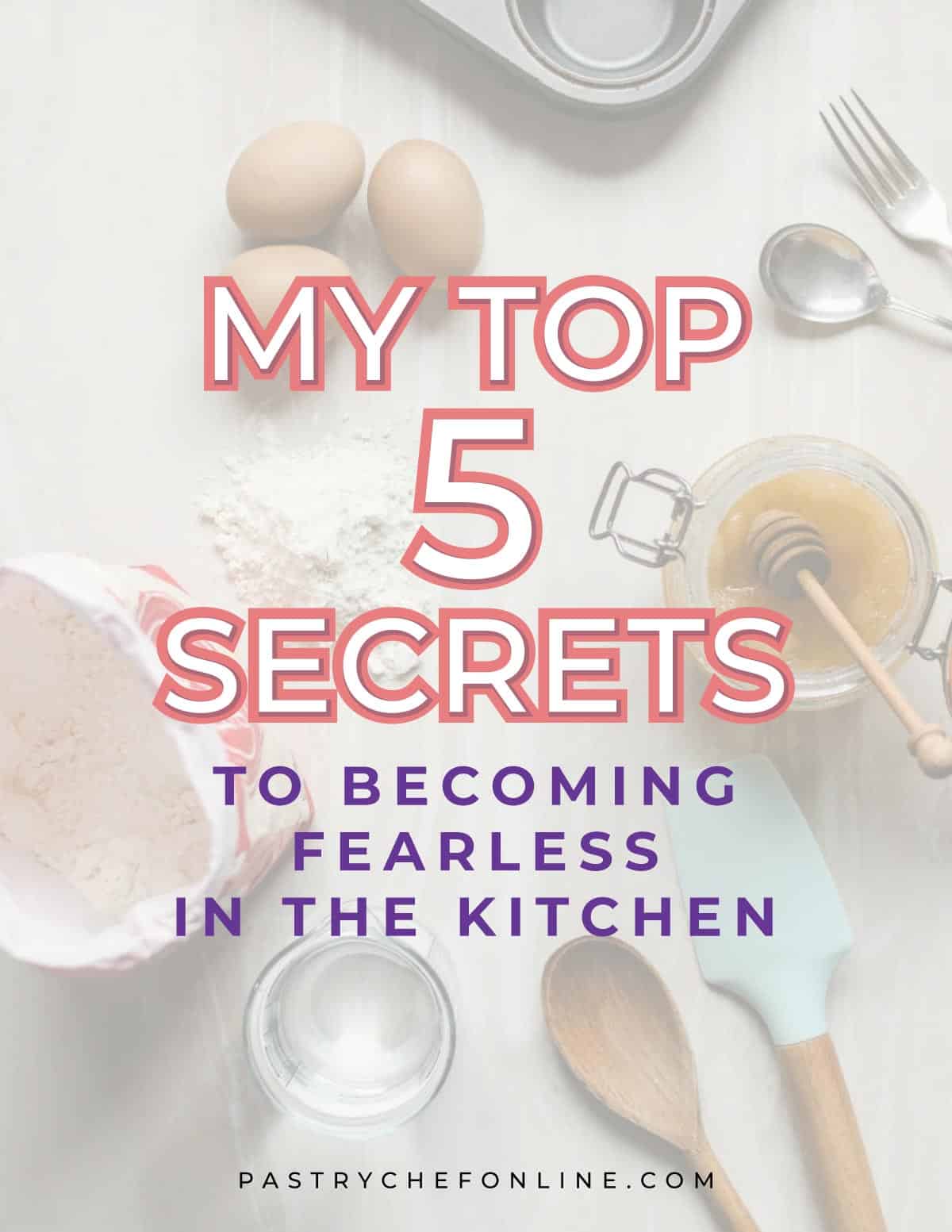
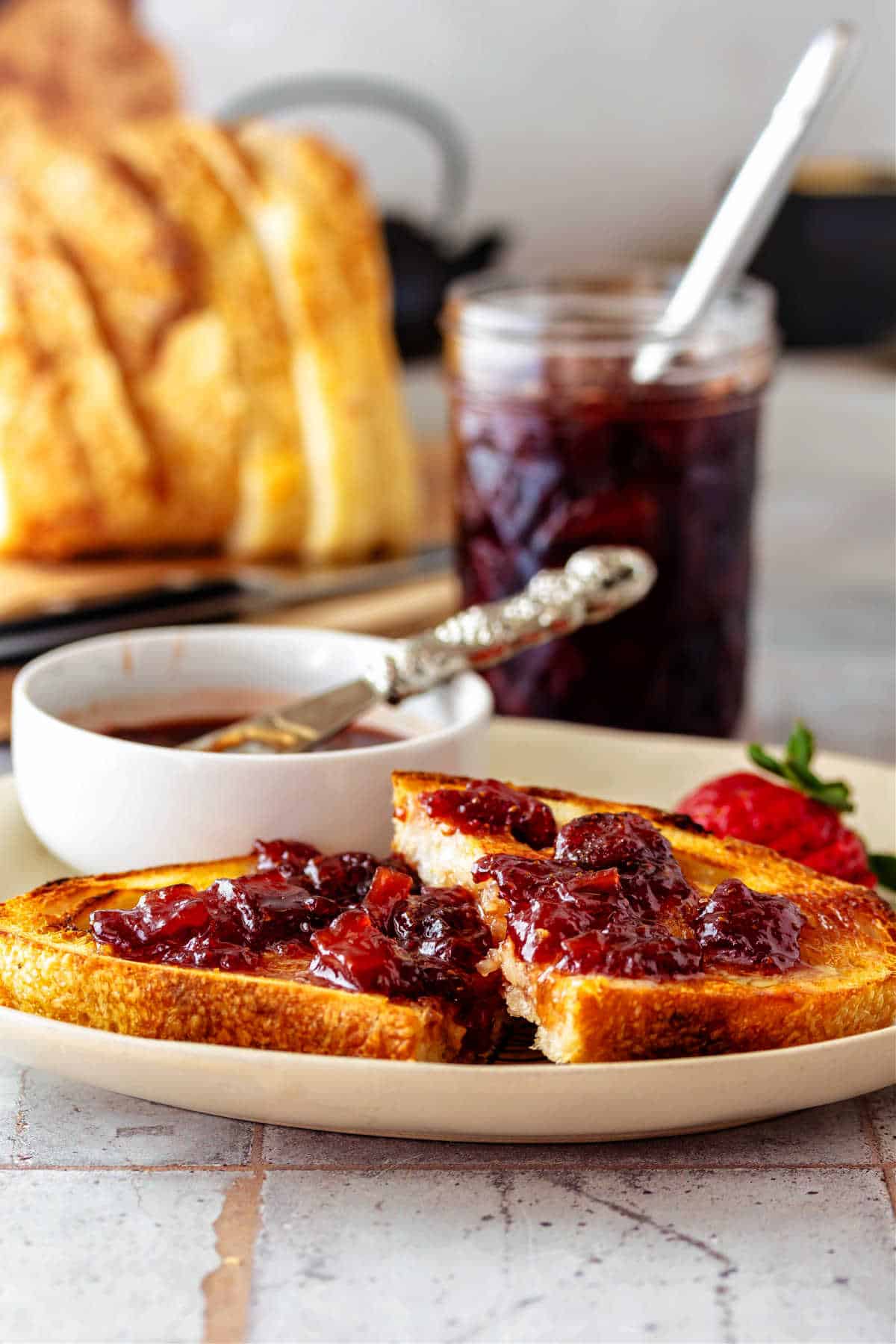
Join in Today!
What a wonderful and informative post! Haven’t made a brioche at home in ages. I must do so while I am on a break from work.And I don’t think they were too overproofed.
Thank you, friend! You don’t think they were overproofed? Well, thanks! They did squish under their own weight–the first one anyway. I think it was because I was Overly Eager to turn them out of their pans. I waited on the second one a bit longer. Either way, really tasty, though! xo
Even the name of this bread is elegant. I love brioche and while you say the smell of champagne dissipates, I choose to believe that I’ll be able to smell it even as I slather butter and jam all over my first slice. Happy New Year!
I think I’ll go with what you said, Laura! Happy New Year to you, too! =)
This is an absolutely gorgeous loaf of bread, my friend! I’ve never worked with champagne yeast, so this was a complete revelation for me! Clearly I need to broaden my baking, especially since I’ve yet to make my own brioche! You’ve motivated me!!!
It’s kind of fun to play with brewer’s yeast in baking. Each strain yields subtle differences so you end up with something familiar yet maybe just a tiny bit unexpected!
Spectacular perfection! Jenni you did it again, the perfect accompaniment to our New Year’s Eve Extravaganza! I love how you always teach us something new and exciting. You are amazing!
Thanks so much, Jane! And I know I said over at your place, but man your photos of that incredible beef were *on point!* <3
your brioche looks spectacular! thanks for sharing this with us
Thanks, Theresa!
Brioche is my favorite bread and yours is so darn tempting!!! Love your tips and will have to try with “champagne” yeast, though the palates in my house would just gobble it up (with butter, of course) without taking a second to discern any differences from a loaf with regular old yeast. I always learn so much from your posts. Thanks, Jenni!!
Honestly, I doubt I could tell the difference if they weren’t side by side, but it’s fun to be a rebel and use brewers yeast in baking! =)